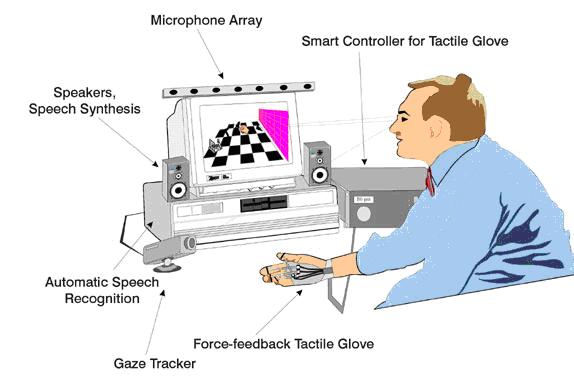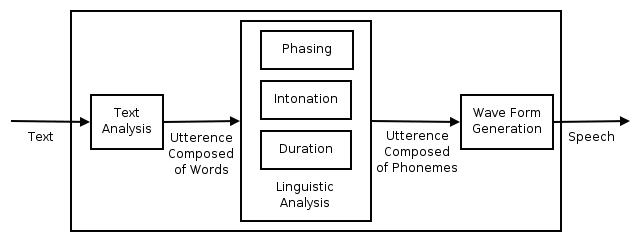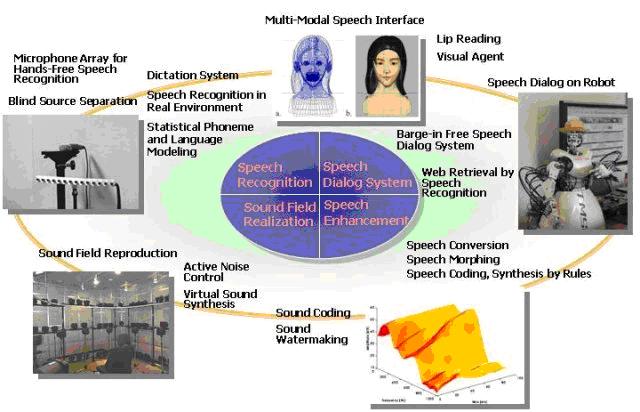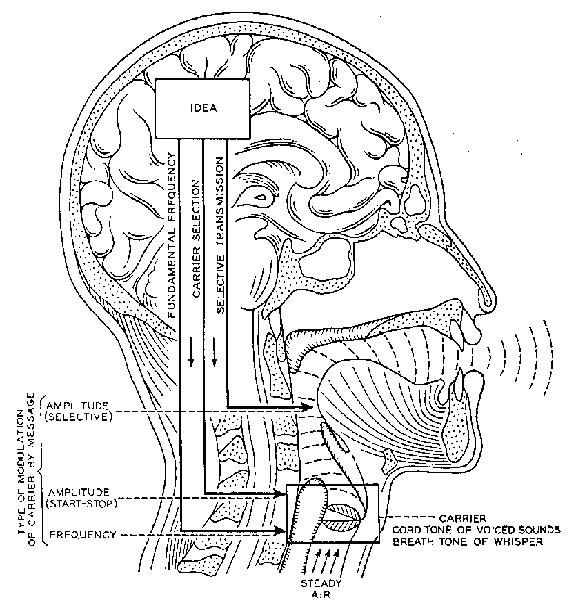Technical Paper Title: SPEECH SYNTHESIS
Authors: T .SRAVYA & R.VASAVI, 2nd BTech, CSE
College: Sai Spurthi Institute of Technology, Sathupalli, Khammam
Introduction:
Speech synthesis is the artificial production of human speech. A computer system used for this purpose is called a speech synthesizer, and can be implemented in software or hardware. A text-to-speech (TTS) system converts normal language text into speech; other systems render symbolic linguistic representations like phonetic transcriptions into speech
Synthesized speech can be created by concatenating pieces of recorded speech that are stored in a database. Systems differ in the size of the stored speech units; a system that stores phones or diphones provides the largest output range, but may lack clarity. For specific usage domains, the storage of entire words or sentences allows for high-quality output. Alternatively, a synthesizer can incorporate a model of the vocal tract and other human voice characteristics to create a completely “synthetic” voice output.
The quality of a speech synthesizer is judged by its similarity to the human voice and by its ability to be understood. An intelligible text-to-speech program allows people with visual impairments or reading disabilities to listen to written works on a home computer. Many computer operating systems have included speech synthesizers since the early 1980s.
BLOCK DIAGRAM:

CONTENTS:
• OVERVIEW OF TEXT PROCESSING
• ELECTRONIC DEVICES
• SYNTHESIZER TECHNOLOGIES
• TEXT NORMALIZATION CHALLENGE
• COMPUTER OPERATING SYSTEMS
• SPEECH SYNTHESIS MARKUP LANGUAGES
• APPLICATIONS
• CONCLUSION
Overview of text processing

Overview of a typical TTS system
A text-to-speech system (or “engine”) is composed of two parts: a front-end and a back-end. The front-end has two major tasks. First, it converts raw text containing symbols like numbers and abbreviations into the equivalent of written-out words. This process is often called text normalization, pre-processing, or tokenization. The front-end then assigns phonetic transcriptions to each word, and divides and marks the text into prosodic units, like phrases, clauses, and sentences. The process of assigning phonetic transcriptions to words is called text-to-phoneme or grapheme-to-phoneme conversion.[3] Phonetic transcriptions and prosody information together make up the symbolic linguistic representation that is output by the front-end. The back-end—often referred to as the synthesizer—then converts the symbolic linguistic representation into sound.
Electronic devices:
The first computer-based speech synthesis systems were created in the late 1950s, and the first complete text-to-speech system was completed in 1968. In 1961, physicist John Larry Kelly, Jr and colleague Louis Gerstman used an IBM 704 computer to synthesize speech, an event among the most prominent in the history of Bell Labs. Kelly’s voice recorder synthesizer (vocoder) recreated the song “Daisy Bell”, with musical accompaniment from Max Mathews. Coincidentally, Arthur C. Clarke was visiting his friend and colleague John Pierce at the Bell Labs Murray Hill facility. Clarke was so impressed by the demonstration that he used it in the climactic scene of his screenplay for his novel 2001: A Space Odyssey] .where the HAL 9000 computer sings the same song as it is being put to sleep by astronaut Dave Bowman. Despite the success of purely electronic speech synthesis, research is still being conducted into mechanical speech synthesizers.
Synthesizer technologies:
The most important qualities of a speech synthesis system are naturalness and intelligibility. Naturalness describes how closely the output sounds like human speech, while intelligibility is the ease with which the output is understood. The ideal speech synthesizer is both natural and intelligible. Speech synthesis systems usually try to maximize both characteristics.
The two primary technologies for generating synthetic speech waveforms are concatenative synthesis and formant synthesis. Each technology has strengths and weaknesses, and the intended uses of a synthesis system will typically determine which approach is used.of hours of speech Also, unit selection algorithms have been known to select segments from a place that results in less than ideal synthesis (e.g. minor words become unclear) even when a better choice exists in the database
Diphone synthesis:
Diphone synthesis uses a minimal speech database containing all the diphones (sound-to-sound transitions) occurring in a language. The number of diphones depends on the phonotactics of the language: for example, Spanish has about 800 diphones, and German about 2500. In diphone synthesis, only one example of each diphone is contained in the speech database. At runtime, the target prosody of a sentence is superimposed on these minimal units by means of digital signal processing techniques such as linear predictive coding, PSOLA[15] or MBROLA. The quality of the resulting speech is generally worse than that of unit-selection systems, but more natural-sounding than the output of formant synthesizers. Diphone synthesis suffers from the sonic glitches of concatenative synthesis and the robotic-sounding nature of formant synthesis, and has few of the advantages of either approach other than small size. As such, its use in commercial applications is declining, although it continues to be used in research because there are a number of freely available software implementations.
Formant synthesis:
Formant synthesis does not use human speech samples at runtime. Instead, the synthesized speech output is created using an acoustic model. Parameters such as fundamental frequency, voicing, and noise levels are varied over time to create a waveform of artificial speech. This method is sometimes called rules-based synthesis; however, many concatenative systems also have rules-based components.
Many systems based on formant synthesis technology generate artificial, robotic-sounding speech that would never be mistaken for human speech. However, maximum naturalness is not always the goal of a speech synthesis system, and formant synthesis systems have advantages over concatenative systems. Formant-synthesized speech can be reliably intelligible, even at very high speeds, avoiding the acoustic glitches that commonly plague concatenative systems. High-speed synthesized speech is used by the visually impaired to quickly navigate computers using a screen reader. Formant synthesizers are usually smaller programs than concatenative systems because they do not have a database of speech samples. They can therefore be used in embedded systems, where memory and microprocessor power are especially limited. Because formant-based systems have complete control of all aspects of the output speech, a wide variety of prosodies and intonations can be output, conveying not just questions and statements, but a variety of emotions and tones of voice.
Text normalization challenges:
The process of normalizing text is rarely straightforward. Texts are full of heteronyms, numbers, and abbreviations that all require expansion into a phonetic representation. There are many spellings in English which are pronounced differently based on context. For example, “My latest project is to learn how to better project my voice” contains two pronunciations of “project”.
Most text-to-speech (TTS) systems do not generate semantic representations of their input texts, as processes for doing so are not reliable, well understood, or computationally effective. As a result, various heuristic techniques are used to guess the proper way to disambiguate homographs, like examining neighboring words and using statistics about frequency of occurrence.
Recently TTS systems have begun to use HMMs (discussed above) to generate “parts of speech” to aid in disambiguating homographs. This technique is quite successful for many cases such as whether “read” should be pronounced as “red” implying past tense, or as “reed” implying present tense. Typical error rates when using HMMs in this fashion are usually below five percent. These techniques also work well for most European languages, although access to required training corpora is frequently difficult in these languages.
.prosodics and emotional content:
A recent study reported in the journal “Speech Communication” by Amy Drahota and colleagues at the University of Portsmouth, UK, reported that listeners to voice recordings could determine, at better than chance levels, whether or not the speaker was smiling.[ It was suggested that identification of the vocal features which signal emotional content may be used to help make synthesized speech sound more natural.
Computer operating systems or outlets with speech synthesis
Apple
The first speech system integrated into an operating system was Apple Computer’s MacInTalk in 1984. Since the 1980s Macintosh Computers offered text to speech capabilities through The MacinTalk software. In the early 1990s Apple expanded its capabilities offering system wide text-to-speech support. With the introduction of faster PowerPC-based computers they included higher quality voice sampling. Apple also introduced speech recognition into its systems which provided a fluid command set. More recently, Apple has added sample-based voices. Starting as a curiosity, the speech system of Apple Macintosh has evolved into a cutting edge fully-supported program, Plain Talk, for people with vision problems. VoiceOver was included in Mac OS X Tiger and more recently Mac OS X Leopard. The voice shipping with Mac OS X 10.5 (“Leopard”) is called “Alex” and features the taking of realistic-sounding breaths between sentences, as well as improved clarity at high read rates. The operating system also includes say, a command-line based application that converts text to audible speech.[25]
MICROSOFT WINDOWS:
Modern Windows systems use SAPI4- and SAPI5-based speech systems that include a speech recognition engine (SRE). SAPI 4.0 was available on Microsoft-based operating systems as a third-party add-on for systems like Windows 95 and Windows 98. Windows 2000 added a speech synthesis program called Narrator, directly available to users. All Windows-compatible programs could make use of speech synthesis features, available through menus once installed on the system. Microsoft Speech Server is a complete package for voice synthesis and recognition, for commercial applications such as call centers.
Android
Version 1.6 of Android added support for speech synthesis (TTS).
Internet
Currently, there are a number of applications, plugins and gadgets that can read messages directly from an e-mail client and web pages from a web browser. Some specialized software can narrate RSS-feeds. On one hand, online RSS-narrators simplify information delivery by allowing users to listen to their favourite news sources and to convert them to podcasts. On the other hand, on-line RSS-readers are available on almost any PC connected to the Internet. Users can download generated audio files to portable devices, e.g. with a help of podcast receiver, and listen to them while walking, jogging or commuting to work.
Speech synthesis markup languages
A number of markup languages have been established for the rendition of text as speech in an XML-compliant format. The most recent is Speech Synthesis Markup Language (SSML), which became a W3C recommendation in 2004. Older speech synthesis markup languages include Java Speech Markup Language (JSML) and SABLE. Although each of these was proposed as a standard, none of them has been widely adopted.
Speech synthesis markup languages are distinguished from dialogue markup languages. Voice XML, for example, includes tags related to speech recognition, dialogue management and touchtone dialing, in addition to text-to-speech markup.

Applications:
Speech synthesis has long been a vital assistive technology tool and its application in this area is significant and widespread. It allows environmental barriers to be removed for people with a wide range of disabilities. The longest application has been in the use of screen readers for people with visual impairment, but text-to-speech systems are now commonly used by people with dyslexia and other reading difficulties as well as by pre-literate youngsters. They are also frequently employed to aid those with severe speech impairment usually through a dedicated voice output communication aid.
Sites such as Ananova and YAKiToMe! have used speech synthesis to convert written news to audio content, which can be used for mobile applications.
Speech synthesis techniques are used as well in the entertainment productions such as games, anime and similar. In 2007, Animo Limited announced the development of a software application package based on its speech synthesis software Fine Speech, explicitly geared towards customers in the entertainment industries, able to generate narration and lines of dialogue according to user specifications. The application reached maturity in 2008, when NEC Biglobe announced a web service that allows users to create phrases from the voices of Code Geass:Lelouch of the Rebellion R2 characters.
TTS applications such as YAKiToMe! and Speakonia are often used to add synthetic voices to YouTube videos for comedic effect, as in Barney Bunch videos. YAKiToMe! is also used to convert entire books for personal podcasting purposes, RSS feeds and web pages for news stories, and educational texts for enhanced learning.
CONCLUSION:
There is more than one way to generate synthetic speech
whose durations mimic those of natural speech.Techniques
may or may not use some prefered piece of timing.In generating
synthetic speech whose rhythm is right for the language being
modeled,it is important to model relations between syllables rather than
to concentrate almost exclusively on individual syllables or segments,or on
segmental durations
REFERENCES:
C.P.Browman and L.M.Goldstein. Towards an articulatory
phonology.
W.N.Campbell and S.D.Isard.Segment durations in a syllable fra

